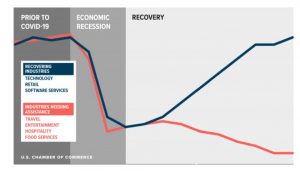K-shaped Economic Recovery:

The prospects of a K-shaped recovery from COVID are increasing both in India and across the world.
- A K-shaped recovery happens when different sections of an economy recover at starkly different rates.
- Households at the top of the pyramid are likely to have seen their in- comes largely protected, and savings rates forced up during the lockdown, increasing ‘fuel in the tank’ to drive future consumption.
- Meanwhile, households at the bottom are likely to have witnessed permanent hits to jobs and incomes.
Macro implications of a K-shaped recovery:
- Upper-income households have benefitted from higher savings for two quarters.
- Households at the bottom have experienced a permanent loss of income in the forms of jobs and wage cuts; this will be a recurring drag on demand, if the labour market does not heal faster.
- To the extent that COVID has triggered an effective income transfer from the poor to the rich, this will be demand-impeding because the poor have a higher marginal propensity to consume (i.e. they tend to spend (instead of saving) a much higher proportion of their income.
- If COVID-19 reduces competition or increases the inequality of incomes and opportunities, it could impinge on trend growth in developing economies by hurting productivity and tightening political economy constraints.




